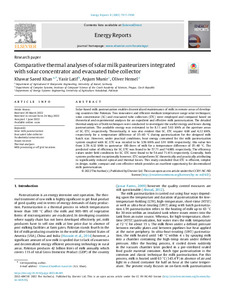| dc.date.accessioned | 2022-08-26T11:14:07Z | |
| dc.date.available | 2022-08-26T11:14:07Z | |
| dc.date.issued | 2022 | |
| dc.identifier | doi:10.17170/kobra-202208266766 | |
| dc.identifier.uri | http://hdl.handle.net/123456789/14105 | |
| dc.description.sponsorship | Gefördert durch den Publikationsfonds der Universität Kassel | ger |
| dc.language.iso | eng | |
| dc.rights | Attribution-NonCommercial-NoDerivatives 4.0 International | * |
| dc.rights.uri | http://creativecommons.org/licenses/by-nc-nd/4.0/ | * |
| dc.subject | solar milk pasteurization | eng |
| dc.subject | evacuated tube collector | eng |
| dc.subject | paraboloidal concentrator | eng |
| dc.subject | steam receiver | eng |
| dc.subject | thermal analyses | eng |
| dc.subject | milk processing at off grid locations | eng |
| dc.subject.ddc | 630 | |
| dc.title | Comparative thermal analyses of solar milk pasteurizers integrated with solar concentrator and evacuated tube collector | eng |
| dc.type | Aufsatz | |
| dcterms.abstract | Solar-based milk pasteurization enables decentralized maintenance of milk in remote areas of developing countries like Pakistan. Two innovative and efficient medium temperature range solar techniques; solar concentrator (SC) and evacuated tube collectors (ETC) were employed and compared based on theoretical and experimental analyses for an expedient and effective milk pasteurization. The detailed thermal analyses of both techniques were conducted to investigate the useful energy and losses during pasteurization. The available energy was estimated to be 8.11 and 5.63 kWh at the aperture areas of SC, ETC, respectively. Theoretically, it was also evident that SC, ETC require 4.68 and 4.22 kWh, respectively for a temperature difference of 35–40 °C during pasteurization for the designed milk batch size. However, under practical conditions, heat energy consumed for the milk pasteurization system coupled with SC, ETC was recoded to be 3.56 kWh and 3.91 kWh respectively; this value lies from 3.78–4.32 kWh to pasteurize 100-liters of milk for a temperature difference of 35–40 °C. The predicted value of efficiency for SC, ETC was found to be 57.71 and 74.88% respectively. The efficiency values under field conditions for SC, ETC were found to be 54 and 71.41% respectively. Generally, both systems performed exceptionally however, ETC outperforms SC theoretically and practically attributing to significantly reduced optical and thermal losses. This study concluded that ETC is efficient, simpler in design, stable, compact and cost-effective which provides an excellent opportunity for decentralized milk pasteurization. | eng |
| dcterms.accessRights | open access | |
| dcterms.creator | Khan, Khawar Saeed | |
| dcterms.creator | Latif, Yasir | |
| dcterms.creator | Munir, Anjum | |
| dcterms.creator | Hensel, Oliver | |
| dc.relation.doi | doi:10.1016/j.egyr.2022.06.001 | |
| dc.subject.swd | Pakistan | ger |
| dc.subject.swd | Pasteurisieren | ger |
| dc.subject.swd | Nachhaltigkeit | ger |
| dc.subject.swd | Solartechnik | ger |
| dc.subject.swd | Energieeffizienz | ger |
| dc.subject.swd | Milchwirtschaft | ger |
| dc.subject.swd | Kostensenkung | ger |
| dc.subject.swd | Milchversorgung | ger |
| dc.subject.swd | Erneuerbare Energien | ger |
| dc.subject.swd | Thermoanalyse | ger |
| dc.subject.swd | Supply Chain Management | eng |
| dc.type.version | publishedVersion | |
| dcterms.source.identifier | eissn:2352-4847 | |
| dcterms.source.journal | Energy Reports | eng |
| dcterms.source.pageinfo | 7917-7930 | |
| dcterms.source.volume | Volume 8 | |
| kup.iskup | false | |


